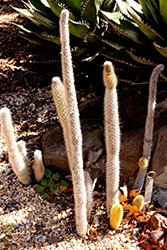Fri & Sat 8am - 8pm
Sun 8am - 7pm
Anytown, USA 12345
fax: 261.787.0463
e-mail: info@successgc.com


Plant Finder

Height: 5 feet
Spread: 24 inches
Sunlight:
![]()
Hardiness Zone: 10a
Other Names: Velvet Cactus, Snake Cactus, Golden Club Cactus
Description:
An erect, thorny columnar cactus that forms colonies of thin cylindrical gray-green stems covered with golden spines; yellow flowers in spring, followed by purplish red fruits; an outstanding vertical accent for the garden or containers
Ornamental Features
Golden-spined Cereus is a member of the cactus family, which are grown primarily for their characteristic shapes, their interesting features and textures, and their high tolerance for hot, dry growing environments. Like all cacti, it doesn't actually have leaves, but rather modified succulent stems that comprise the bulk of the plant, and which are designed to hold water for long periods of time. This particular cactus is valued for its rigidly upright and cylindrical habit of growth consisting of a cluster of spiny ribbed grayish green stem segments held tightly together. This plant has yellow daisy flowers with burgundy tips along the branches from early to late spring, which are interesting on close inspection. It features an abundance of magnificent red berries with deep purple blush from late summer to early fall.
Landscape Attributes
Golden-spined Cereus is a succulent evergreen plant with a strongly upright, cylindrical form. As a type of cactus, it has no true foliage; the body of the plant is wholly comprised of a tight cluster of spiny grayish green stems which are prominently ribbed. With age, this plant will eventually develop a woody gray 'trunk' at its base.
This is a relatively low maintenance plant, and should never be pruned except to remove any dieback, as it tends not to take pruning well. It is a good choice for attracting birds to your yard, but is not particularly attractive to deer who tend to leave it alone in favor of tastier treats. Gardeners should be aware of the following characteristic(s) that may warrant special consideration;
- Insects
- Spiny
Golden-spined Cereus is recommended for the following landscape applications;
- Accent
- Vertical Accent
- Hedges/Screening
- General Garden Use
- Naturalizing And Woodland Gardens
- Container Planting
Planting & Growing
Golden-spined Cereus will grow to be about 5 feet tall at maturity, with a spread of 24 inches. It is often either grown as a solitary specimen or permitted to grow into a broader colony as part of a garden composition. It grows at a slow rate, and under ideal conditions can be expected to live for 60 years or more.
This plant should only be grown in full sunlight. It prefers dry to average moisture levels with very well-drained soil, and will often die in standing water. It is considered to be drought-tolerant, and thus makes an ideal choice for a low-water garden or xeriscape application. Like most succulents and cacti, this plant prefers to grow in poor soils and should therefore never be fertilized. It is not particular as to soil pH, but grows best in sandy soils. It is somewhat tolerant of urban pollution. This species is native to parts of North America.
Golden-spined Cereus is a fine choice for the garden, but it is also a good selection for planting in outdoor pots and containers. Because of its height, it is often used as a 'thriller' in the 'spiller-thriller-filler' container combination; plant it near the center of the pot, surrounded by smaller plants and those that spill over the edges. It is even sizeable enough that it can be grown alone in a suitable container. Note that when growing plants in outdoor containers and baskets, they may require more frequent waterings than they would in the yard or garden.
